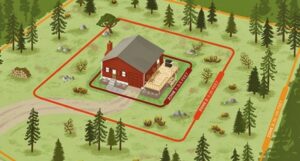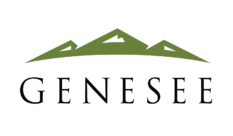Inventory/Mitigate/Harden/Evacuate
Mitigate

 Mitigate your property. Mitigation, to some people, brings visions of a barren wasteland surrounding their home, when in fact, a well-mitigated property is not only pleasing to the eye, but easier to maintain than a property left to grow uncontrolled on its own. A well-mitigated property consists of three zones surrounding the home. Within those zones trees are limbed up from the ground, groups of trees are spaced to minimize crown fires, and ladder fuels (grasses and shrubs which allow ground fires to ignite trees) are eliminated.
Mitigate your property. Mitigation, to some people, brings visions of a barren wasteland surrounding their home, when in fact, a well-mitigated property is not only pleasing to the eye, but easier to maintain than a property left to grow uncontrolled on its own. A well-mitigated property consists of three zones surrounding the home. Within those zones trees are limbed up from the ground, groups of trees are spaced to minimize crown fires, and ladder fuels (grasses and shrubs which allow ground fires to ignite trees) are eliminated.
When complete, a well-mitigated property (a “defensible space”) WILL NOT look like the picture at the right…
Mitigate your property; create a Defensible Space.
A well-mitigated property consists of three zones surrounding the home:

Immediate Zone; 0 to 5 feet: A non-combustible area with no flammable mulch or shrubs, and preferably no trees.
Intermediate Zone; 5 to 30 feet: Fire-resistant, low growing grasses, and preferably no trees within 15 feet of the house.
Extended Zone; 30 to 100 feet: Reduced amounts of dead branches and pine needles on the ground, and trees limbed up and spaced properly. Store one season’s worth of firewood in this zone, but away from trees.
In each of the three zones (where appropriate):
- Limb up trees. Remove bottom limbs so that the lowest limbs of the tree are 6 to 10 feet above the ground at their lowest points. For small trees, remove no more limbs than one-third the height of the tree.
- Increase crown spacing of trees or tree groups. Crown spacing is the distance between the widest part of the trees, and should be no less than 10 feet, more if the trees are on a slope.
- Remove ladder fuels. Cut back or remove any small shrubs or tall grasses which are beneath trees. Flame lengths from ladder fuels can be up to three times the length of the original shrub or grass.
Minimize firewood storage:
- Store only enough firewood for one season.
- If you can’t store your firewood in your garage, store it only in the Extended Zone, and away from trees or other flammable material.
Getting into the weeds…
Most mitigation information details removing vegetation around your home, but careful use of fire-resistant plants can enhance your property while minimizing the threat of fire to your home’s structure. There are several publications, listed below, that will help you determine what plants to use around your home that will minimize the threat of fire and minimize the use of water while adding to the interest of the landscaping on your property.
“Getting into the weeds” resources: Information about specific plants to use in landscaping.
Fire-Resistant Landscaping 4p:
A good overview of the topic with references to more detailed information. This is a good place to start when considering landscaping that will help to keep you safe.
Low-Flammability Landscape Plants Fact Sheet 6.305, 8p:
An updated list of plants to FireWise Plant Materials (above) with plants again listed alphabetically by Scientific Name. This plant list overlaps, but is not identical to, the reference above. This is also available HERE as a searchable and sortable Microsoft Excel spreadsheet.
This is a Microsoft Excel version of the two plant lists from FireWise Plant Materials and Low-Flammability Landscape Plants (above). Unlike the two static lists arranged by Scientific Name, this combined list can be ordered and sorted by any of the columns in the Combined worksheet. Because the two documents have different information, the combined version will have blank cells when a plant is present in only one of the lists.
Each of the lists is also in its own worksheet and is sortable like the combined list. While the file is a Microsoft Excel spreadsheet, it can be easily imported to Google Sheets if that is preferable software to you.
Mitigation resources: Information about creating a Defensible Space around your home:
Landscape Design for Ignition Resistance video 5:34:
A good introduction to landscaping in the wildland urban interface (WUI). A lot of information to consider in planning and before planning a landscaping project.
The Home Ignition Zone 16p; especially pp.4-6, 8-10:
A lot of information about mitigation and home hardening, as well as general information about forest types and fuel types in the forests.
Wildfire Mitigation
This is the home page for CSFS wildfire mitigation. There is a lot of information here about mitigation and plants to use to enhance mitigation efforts.
